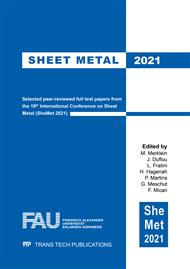[1]
C. Wang, Y. Yu, J. Yu, Y. Zhang, Y. Zhao, Q. Yuan, Microstructure evolution and corrosion behavior of dissimilar 304/430 stainless steel welded joints, J. Manuf. Process 50 (2020) 183-191.
DOI: 10.1016/j.jmapro.2019.12.015
Google Scholar
[2]
X. Zhang, G. Mi, C. Wang, Microstructure and performance of hybrid laser-arc welded high-strength low alloy steel and austenitic stainless steel dissimilar joint, Opt. Laser Technol. 122 (2020).
DOI: 10.1016/j.optlastec.2019.105878
Google Scholar
[3]
H. Di, Q. Sun, X. Wang, J. Li, Microstructure and properties in dissimilar/similar weld joints between DP780 and DP980 steels processed by fiber laser welding, J. Mater. Sci. Technol. 33 (2017) 1561-1571.
DOI: 10.1016/j.jmst.2017.09.001
Google Scholar
[4]
E.M. Stanciu, A. Pascu, I. C. Roata, C. Croitoru, M. H. Tierean, Laser welding of dissimilar materials, Mater. Today-Proc. 19 (2019) 1066-1072.
DOI: 10.1016/j.matpr.2019.08.022
Google Scholar
[5]
M.R. Nekouie Esfahani, J. Coupland, S. Marimuthu, Microstructural and mechanical characterisation of laser-welded high-carbon and stainless steel, Int. J. Adv. Manuf. Technol. 80 (2015) 1449-1456.
DOI: 10.1007/s00170-015-7111-5
Google Scholar
[6]
H. Gong, S. Wang, P. Knysh, Y.P. Korkolis, Experimental investigation of the mechanical response of laser-welded dissimilar blanks from advanced- and ultra-high-strength steels, Mater. Des. 90 (2016) 1115-1123.
DOI: 10.1016/j.matdes.2015.11.057
Google Scholar
[7]
W. Meng, Z. Li, J. Huang, Y. Wu, S. Katayama, Microstructure and softening of laser-welded 960 MPa grade high strength steel joints, J. Mater. Eng. Perform. 23 (2014) 538-544.
DOI: 10.1007/s11665-013-0795-5
Google Scholar
[8]
M. Mazar Atabaki, N. Yazdian, J. Ma, R. Kovacevic, High power laser welding of thick steel plates in a horizontal butt joint configuration, Opt. Laser Technol. 83 (2016) 1-12.
DOI: 10.1016/j.optlastec.2016.03.016
Google Scholar
[9]
K.P. Mehta, Sustainability in welding and processing. In: Gupta K. (eds) innovations in manufacturing for sustainability. Materials Forming, Machining and Tribology. Springer, Cham. (2019) 25-145.
DOI: 10.1007/978-3-030-03276-0_6
Google Scholar
[10]
Y. Chang, G. Sproesser, S. Neugebauer, K. Wolf, R. Scheumann, A. Pittner, M. Rethmeier, M. Finkbeiner, Environmental and social life cycle assessment of welding technologies, Procedia CIRP 26 (2015) 293-298.
DOI: 10.1016/j.procir.2014.07.084
Google Scholar
[11]
M.M.A. Khan, L. Romoli, G. Dini, Laser beam welding of dissimilar ferritic/martensitic stainless steels in a butt joint configuration, Opt. Laser Technol. 49 (2013) 125-136.
DOI: 10.1016/j.optlastec.2012.12.025
Google Scholar
[12]
A. P. Tadamalle, Y.P. Reddy, E. Ramjee, K. Vijaya Kumar Reddy, Characterization of fully and partially penetrated Nd:YAG laser-weld dissimilar metal joints, J. Mech. Sci. Technol. 32 (2018) 615-621.
DOI: 10.1007/s12206-018-0108-2
Google Scholar
[13]
H. Sumi, K. Oi, K. Yasuda, Effect of chemical composition on microstructure and mechanical properties of laser weld metal of high-tensile-strength steel, Weld World 59 (2015) 173-178.
DOI: 10.1007/s40194-014-0191-2
Google Scholar
[14]
Z. Jiang, X. Chen, K. Yu, Z. Lei, Y. Chen, S. Wu, Z. Li, Improving fusion zone microstructure inhomogeneity in dissimilar-metal welding by laser welding with oscillation, Mater. Lett. 261 (2020).
DOI: 10.1016/j.matlet.2019.126995
Google Scholar
[15]
M. Hietala, A. Hamada, M. Keskitalo, M. Jaskari, A. Järvenpää, Microstructural evolution of laser-welded dissimilar lap joints of martensitic abrasion resistant steel and cold-worked austenitic stainless steel, Key Eng. Mater. 861 (2020) 15-22.
DOI: 10.4028/www.scientific.net/kem.861.15
Google Scholar
[16]
A. Järvenpää, M. Jaskari, A. Kisko, P. Karjalainen, Processing and properties of reversion‐treated austenitic stainless steels, Metals 10(2) (2020) 281.
DOI: 10.3390/met10020281
Google Scholar
[17]
C. Pandey, Mechanical and metallurgical characterization of dissimilar P92/SS304 L welded joints under varying heat treatment regimes. Metall. Mater. Trans. A 51 (2020) 2126-2142.
DOI: 10.1007/s11661-020-05660-0
Google Scholar
[18]
G. Dak, C. Pandey, A critical review on dissimilar welds joint between martensitic and austenitic steel for power plant application, J. Manuf. Process 58 (2020) 377-406.
DOI: 10.1016/j.jmapro.2020.08.019
Google Scholar
[19]
C. Pandey, M.M. Mahapatra, P. Kumar, P. Kumar, N. Saini, J.G. Thakare, S. Kumar, Study on effect of double austenitization treatment on fracture morphology tensile tested nuclear grade P92 steel, Eng. Fail. Analyss. 96 (2019) 158-167.
DOI: 10.1016/j.engfailanal.2018.09.036
Google Scholar


